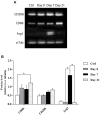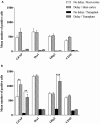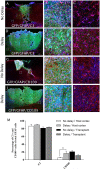Characterization of Inflammation in Delayed Cortical Transplantation
- PMID: 31293384
- PMCID: PMC6603085
- DOI: 10.3389/fnmol.2019.00160
Characterization of Inflammation in Delayed Cortical Transplantation
Abstract
We previously reported that embryonic motor cortical neurons transplanted 1-week after lesion in the adult mouse motor cortex significantly enhances graft vascularization, survival, and proliferation of grafted cells, the density of projections developed by grafted neurons and improves functional repair and recovery. The purpose of the present study is to understand the extent to which post-traumatic inflammation following cortical lesion could influence the survival of grafted neurons and the development of their projections to target brain regions and conversely how transplanted cells can modulate host inflammation. For this, embryonic motor cortical tissue was grafted either immediately or with a 1-week delay into the lesioned motor cortex of adult mice. Immunohistochemistry (IHC) analysis was performed to determine the density and cell morphology of resident and peripheral infiltrating immune cells. Then, in situ hybridization (ISH) was performed to analyze the distribution and temporal mRNA expression pattern of pro-inflammatory or anti-inflammatory cytokines following cortical lesion. In parallel, we analyzed the protein expression of both M1- and M2-associated markers to study the M1/M2 balance switch. We have shown that 1-week after the lesion, the number of astrocytes, microglia, oligodendrocytes, and CD45+ cells were significantly increased along with characteristics of M2 microglia phenotype. Interestingly, the majority of microglia co-expressed transforming growth factor-β1 (TGF-β1), an anti-inflammatory cytokine, supporting the hypothesis that microglial activation is also neuroprotective. Our results suggest that the modulation of post-traumatic inflammation 1-week after cortical lesion might be implicated in the improvement of graft vascularization, survival, and density of projections developed by grafted neurons.
Keywords: cortical lesion; delay; embryonic transplantation; motor cortex; neuroinflammation.
Figures









Similar articles
-
A Delay between Motor Cortex Lesions and Neuronal Transplantation Enhances Graft Integration and Improves Repair and Recovery.J Neurosci. 2017 Feb 15;37(7):1820-1834. doi: 10.1523/JNEUROSCI.2936-16.2017. Epub 2017 Jan 13. J Neurosci. 2017. PMID: 28087762 Free PMC article.
-
Development and Maturation of Embryonic Cortical Neurons Grafted into the Damaged Adult Motor Cortex.Front Neural Circuits. 2016 Aug 3;10:55. doi: 10.3389/fncir.2016.00055. eCollection 2016. Front Neural Circuits. 2016. PMID: 27536221 Free PMC article.
-
Human Neural Stem Cell Transplantation-Mediated Alteration of Microglial/Macrophage Phenotypes after Traumatic Brain Injury.Cell Transplant. 2016 Oct;25(10):1863-1877. doi: 10.3727/096368916X691150. Cell Transplant. 2016. PMID: 26980267
-
Neuronal injury in chronic CNS inflammation.Best Pract Res Clin Anaesthesiol. 2010 Dec;24(4):551-62. doi: 10.1016/j.bpa.2010.11.001. Epub 2010 Nov 29. Best Pract Res Clin Anaesthesiol. 2010. PMID: 21619866 Review.
-
Neocortical grafting to newborn and adult rats: developmental, anatomical and functional aspects.Adv Anat Embryol Cell Biol. 1998;148:1-86. doi: 10.1007/978-3-642-72179-3. Adv Anat Embryol Cell Biol. 1998. PMID: 9670566 Review.
Cited by
-
A Novel Role of Nogo Proteins: Regulating Macrophages in Inflammatory Disease.Cell Mol Neurobiol. 2022 Nov;42(8):2439-2448. doi: 10.1007/s10571-021-01124-0. Epub 2021 Jul 5. Cell Mol Neurobiol. 2022. PMID: 34224050 Free PMC article. Review.
-
Potential Variables for Improved Reproducibility of Neuronal Cell Grafts at Stroke Sites.Cells. 2022 May 17;11(10):1656. doi: 10.3390/cells11101656. Cells. 2022. PMID: 35626693 Free PMC article.
-
Recent Advances in Stem Cell Therapies to Address Neuroinflammation, Stem Cell Survival, and the Need for Rehabilitative Therapies to Treat Traumatic Brain Injuries.Int J Mol Sci. 2021 Feb 17;22(4):1978. doi: 10.3390/ijms22041978. Int J Mol Sci. 2021. PMID: 33671305 Free PMC article. Review.
-
Axonal Extensions along Corticospinal Tracts from Transplanted Human Cerebral Organoids.Stem Cell Reports. 2020 Aug 11;15(2):467-481. doi: 10.1016/j.stemcr.2020.06.016. Epub 2020 Jul 16. Stem Cell Reports. 2020. PMID: 32679062 Free PMC article.
-
Nalbuphine alleviates inflammation by down-regulating NF-κB in an acute inflammatory visceral pain rat model.BMC Pharmacol Toxicol. 2022 Jun 1;23(1):34. doi: 10.1186/s40360-022-00573-7. BMC Pharmacol Toxicol. 2022. PMID: 35642022 Free PMC article.
References
-
- Bernardino L., Xapelli S., Silva A. P., Jakobsen B., Poulsen F. R., Oliveira C. R., et al. . (2005). Modulator effects of interleukin-1β and tumor necrosis factor-α on AMPA-induced excitotoxicity in mouse organotypic hippocampal slice cultures. J. Neurosci. 25, 6734–6744. 10.1523/JNEUROSCI.1510-05.2005 - DOI - PMC - PubMed
-
- Chao C. C., Hu S., Peterson P. K. (1995). Glia, cytokines, and neurotoxicity. Crit. Rev. Neurobiol. 9, 189–205. - PubMed
LinkOut - more resources
Full Text Sources
Research Materials
Miscellaneous

